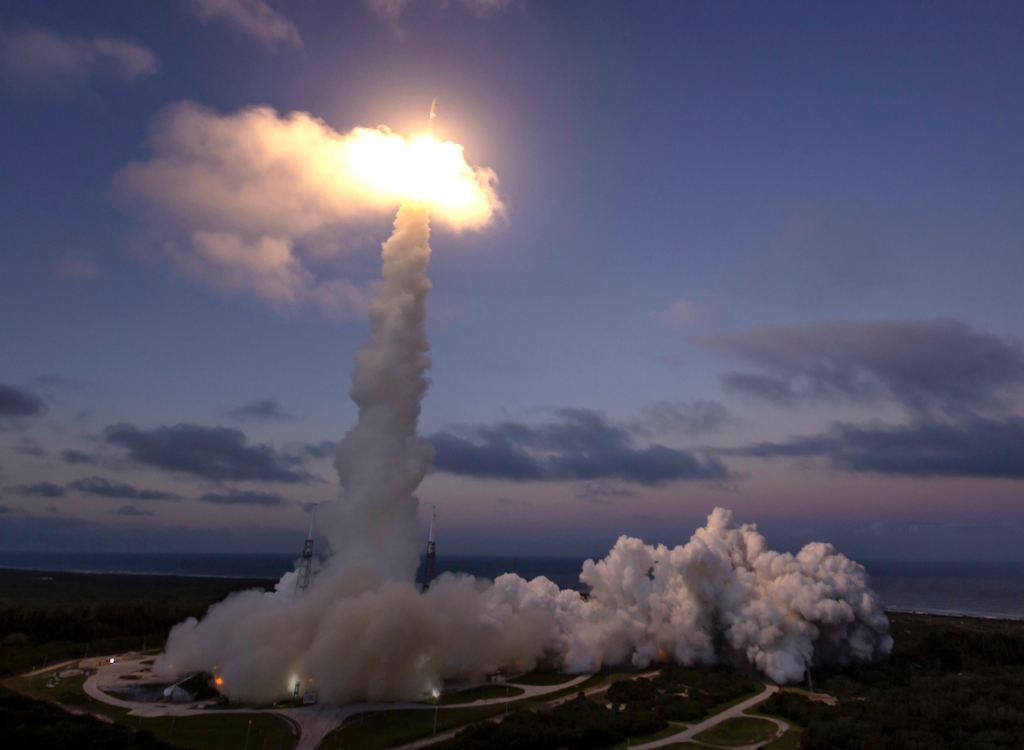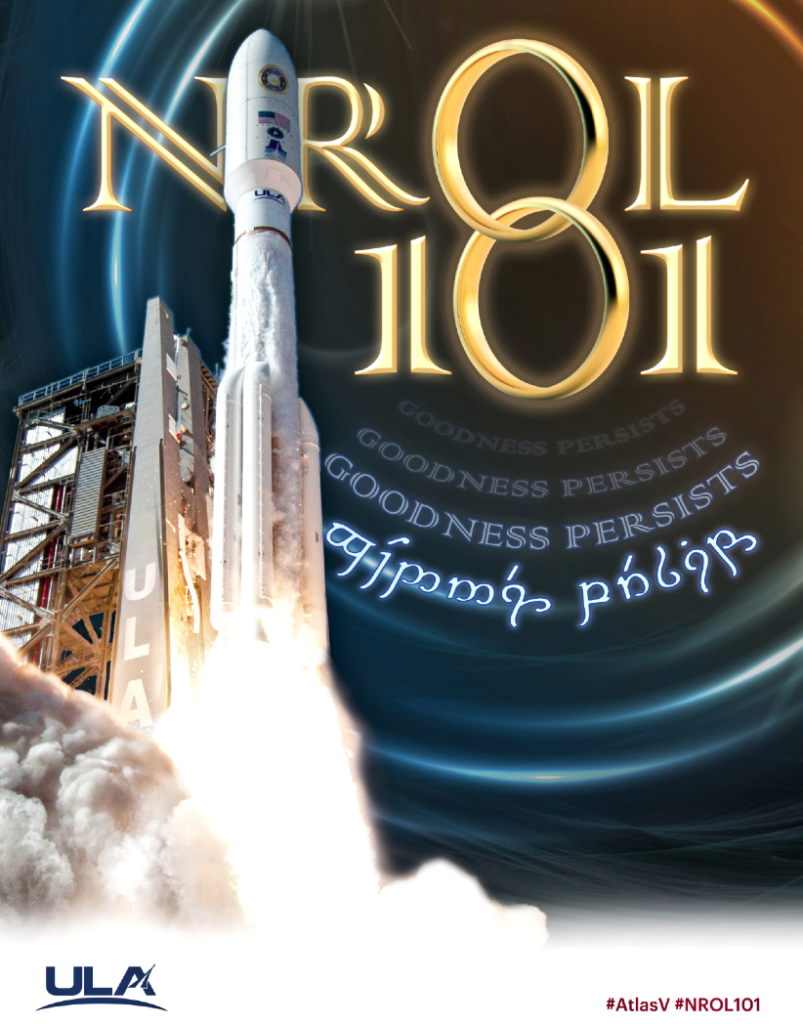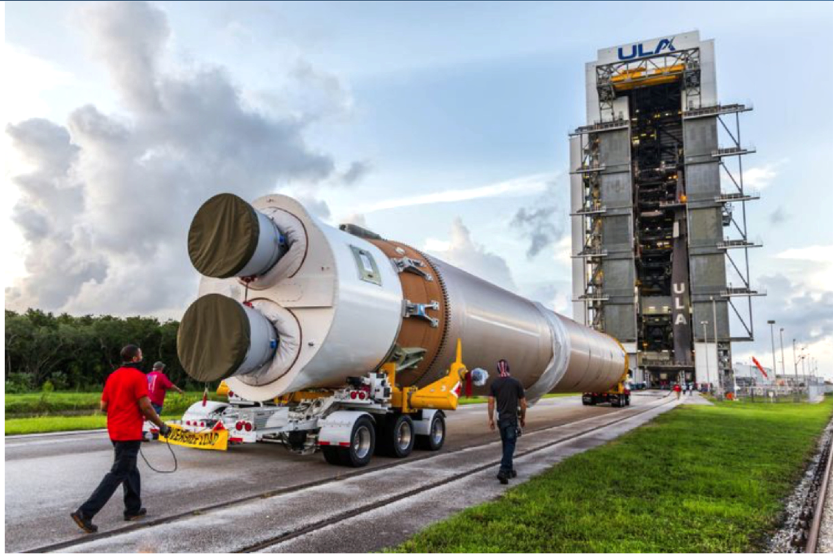
United Launch Alliance (ULA) has successfully launched their Atlas V rocket with the National Reconnaissance Office (NRO) NROL-101 payload aboard on November 13 at 5:32 p.m., EST, from Space Launch Complex-41 at the Cape Canaveral Air Force Station in Florida.

This NROL-101 mission was the first ULA launch flying the new Northrop Grumman Graphite Epoxy Motors (GEM) 63 solid rocket boosters that burn solid propellant that augment the lifting capacity of rocket’s first stage. The GEM 63s measure 63 in. (1.6 meters) in diameter and 66 ft. (20.11 meters) in length. Each GEM 63 produced 371,550 pounds (1.6 mega-Newtons) of max thrust to augment the 860,200 pounds (3.83 mega-Newtons) of thrust produced by the AMROSS RD-180 main engine to power the Atlas V rocket skyward. At liftoff, the combined thrust was nearly 1.8 million pounds or 8 million mega-Newtons.
The Atlas V’s Centaur cryogenic upper stage is powered by Aerojet Rocketdyne’s RL10 engine, which is built in West Palm Beach, Florida, and completed its 500th flight earlier this year. The highly reliable RL10 has long been a mainstay of U.S. national security and space exploration programs, a legacy that will continue with ULA’s Vulcan Centaur rocket, which is expected to debut next year.
For pitch, yaw and roll control, the Centaur relies on 12 Aerojet Rocketdyne MR-106 reaction control thrusters that are built in Redmond, Washington. Pressure tanks provided by Aerojet Rocketdyne’s ARDÉ subsidiary, located in Carlstadt, New Jersey, support both the Centaur as well as the rocket’s first stage.
The Atlas family of launch vehicles has been one of the nation’s workhorses since 1957, successfully launching 668 times. Originally designed by the U.S. Space Force (USSF)’s predecessor organization, it stood alert as the United States’ first intercontinental ballistic missile during the Cold War era.
Since then, the Atlas peacefully launched the first manned spacecraft for Project Mercury, the first generation of Global Positioning System satellites, and various unmanned scientific missions for more than 60 years for both the National Aeronautics and Space Administration and the National Oceanic and Atmospheric Administration.
With its introduction in 2002, the Atlas V variant has successfully placed 48 of 48 National Security space vehicles into their designated orbits. This launch marks the 86th flight of an Atlas V vehicle and the 71st Atlas V launch from SLC-41 at Cape Canaveral Air Force Station, Florida. ULA’s next launch is the NROL-44 mission for the NRO from Cape Canaveral Air Force Station.
This was also the first launch of an Atlas V with the new Northrop Grumman-built Graphite Epoxy Motor (GEM)-63 strap on solid rocket boosters, and a preview of the larger GEM-63XL boosters that will be used on future Vulcan Centaur launch vehicles.
The GEM 63 strap-on boosters (photo above) were developed under a cooperative agreement with ULA to provide additional lift capability for the Atlas V launch vehicle. Each motor contributes 371,500 pounds of additional maximum thrust, and up to five GEM 63 motors can support a single Atlas V launch.
Northrop Grumman has been supplying rocket propulsion to ULA and its heritage companies for a variety of launch vehicles since 1964. The GEM family of strap-on motors started in the early 1980s with the GEM 40, which supported 132 Delta II launches with 1,003 motors.

The company followed with the GEM 46, which flew 63 motors on seven successful missions on the Delta II Heavy launches, and the GEM 60, which retired in August 2019 with 86 motors flown over 26 Delta IV launches. The GEM family has recently expanded with the development of the GEM 63XL variation to support ULA’s Vulcan Centaur launch vehicle.
The company also manufactured the Atlas V rocket’s Reaction Control System propellant tanks at its Commerce, California, facility, and eight retro motors at its Elkton, Maryland, facility that will assist first and second stage separation. To date, ULA has launched 141 times with 100 percent mission success.
Executive Comments
“ULA is proud to play a pivotal role in support of our mission partners and national security by keeping our country safe one launch at a time,” said Gary Wentz, ULA’s VP of Government and Commercial Programs. “This launch was the inaugural launch of our new GEM 63 solid rocket motors, an instrumental step for ULA to build flight experience in preparation for the Vulcan Centaur, our next generation launch vehicle. We thank our mission partners for their continued trust and teamwork. The NROL-101 mission will be ULA’s 29th mission launched for the National Reconnaissance Office and the 17th NRO mission launched on an Atlas V.”
“We take our role in helping to launch critical national security assets into orbit for the National Reconnaissance Office very seriously,” said Eileen P. Drake, Aerojet Rocketdyne’s CEO and President. “Our flight proven and reliable RL10 upper-stage engines have supported these types of missions for nearly six decades, and we look forward to providing them for many years to come.”
“The United States’ launch capability is the envy of the world and our USSF/industry partnership is a large reason why this is true,” said Col. Robert Bongiovi, Director of SMC’s Launch Enterprise. “We are thrilled to celebrate our 83rd consecutive successful launch of the nation’s one-of-a-kind asset made possible through our proven mission assurance program.”
“The GEM 63 rocket motors were developed to enhance the performance of the existing Atlas V launch vehicle while incorporating our flight-proven, heritage designs that provide a significantly lower cost for boost propulsion,” said Charlie Precourt, VP, Propulsion Systems, Northrop Grumman.
